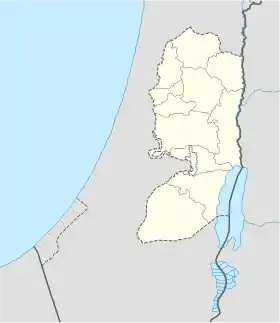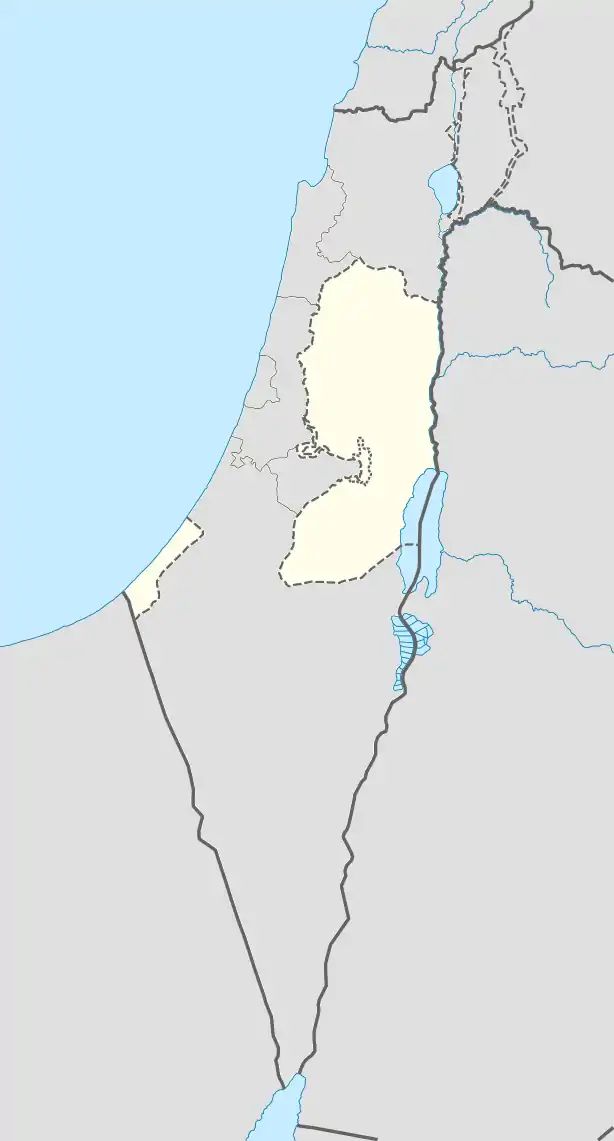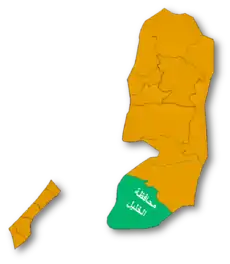Zif | |
|---|---|
| Arabic transcription(s) | |
| • Arabic | زيف |
| Coordinates: 31°27′57″N 35°8′17″E / 31.46583°N 35.13806°E | |
| Palestine grid | 163/098 |
| State | |
| Governorate | Hebron |
| Government | |
| • Type | Village council |
| Population (2017)[1] | |
| • Total | 1,061 |
Zif (Arabic: زيف) is a Palestinian village located 7 kilometers (4.3 mi) south of Hebron. The village is in the Hebron Governorate in the southern West Bank. According to the Palestinian Central Bureau of Statistics, Zif had a population of 1,061 in 2017.[1] The primary health care facilities in the village itself are designated by the Ministry of Health as level 1 and at nearby Yatta as level 3.[2]
History
Iron Age
Zif is identified with the biblical town of Ziph.[3][4] It appears several times in the Hebrew Bible as a town in the vicinity of Hebron that belongs to Tribe of Judah (Joshua 15:20–55). The nearby "Wilderness of Ziph" is mentioned as a place where David hides himself from Saul (1 Samuel 26:1–2). Later, the town of Ziph is said to be fortified by Rehoboam (1 Kings 11:5–8). Its name was found on a number of royal Judahite LMLK seals along with those of Hebron, Socoh and MMST.[5]
Classical Era
Zif existed as a village in the Roman era.[7] It had a Jewish population until at least the 4th century, but it became Christian during the Byzantine period.[8]
The remains of a Byzantine-era Christian communal church have been discovered at Zif.[9] Pot sherds from the Byzantine era have also been found here.[10]
Ottoman Era
In 1838 Edward Robinson was the first to identify the village Zif and its adjacent Tell Zif with the biblical town of Ziph.[11]
In 1863 Victor Guérin visited and described the ruins.[12]
In 1874 surveyors from the PEF Survey of Palestine visited, and noted about Tell ez Zif: "A large mound, partly natural; on the north side a quarry; on the south are tombs. One of these has a single chamber, with a broad bench running round; on the back wall are three kokim with arched roofs, the arches pointed on the left side wall; at the back is another similar koka. A second tomb was a chamber, 8 feet to the back, 9 feet wide, with three recesses, one on each side, one at the back; they are merely shelves, 8 feet by 5 feet, raised some 2 feet. This tomb has a porch in front, supported by two square rock-cut piers.[13]
Zif Today
Zif has been under Israeli occupation since 1967.
In September 2002, a bomb filled with screws and nails, planted by Jewish settlers, exploded in the village's school, wounding five children. A second bomb was found by the school's principal and was detonated by Israeli bomb experts.[14]
References
- 1 2 Preliminary Results of the Population, Housing and Establishments Census, 2017 (PDF). Palestinian Central Bureau of Statistics (PCBS) (Report). State of Palestine. February 2018. pp. 64–82. Retrieved 2023-10-24.
- ↑ "West Bank Health care" (PDF). Archived from the original on 2006-03-13. Retrieved 2016-05-24.
{{cite web}}: CS1 maint: bot: original URL status unknown (link) - ↑ "Ziph | Encyclopedia.com". www.encyclopedia.com. Retrieved 2021-12-13.
- ↑ Schwartz, Joshua (2000). "Dogs, Water and Wall". Scandinavian Journal of the Old Testament. 14 (1): 101–116. doi:10.1080/090183200750022704. ISSN 0901-8328. S2CID 161368221.
- ↑ Naʼaman, Nadav (2005). Ancient Israel and Its Neighbors: Interaction and Counteraction. Eisenbrauns. pp. 164–165. ISBN 9781575061085. Retrieved 5 May 2019.
- ↑ Rainey, A. F. (January 1982). "Wine from the Royal Vineyards". Bulletin of the American Schools of Oriental Research. 245 (245): 57–62. doi:10.2307/1356528. ISSN 0003-097X. JSTOR 1356528. S2CID 164003915.
- ↑ Tsafrir et al, 1994, p. 262
- ↑ Magness, 2003, p. 94
- ↑ Doron Bar, 'The Christianisation of Rural Palestine during_Late Antiquity,' Journal of Ecclesiastical History, Vol. 54, No. 3 July 2003 pp.401-421 p.413.
- ↑ Dauphin, 1998, p. 962
- ↑ Robinson and Smith, 1841, vol 2, pp. 191, 195, 200
- ↑ Guérin, 1869, pp. 160-162
- ↑ Conder and Kitchener, 1883, SWP III, p. 379
- ↑ Schmemann, Serge (2002-09-18). "Bomb Explodes at Palestinian School, Hurting 5 Children". The New York Times. ISSN 0362-4331. Retrieved 2016-06-09.
Bibliography
- Conder, C.R.; Kitchener, H.H. (1883). The Survey of Western Palestine: Memoirs of the Topography, Orography, Hydrography, and Archaeology. Vol. 3. London: Committee of the Palestine Exploration Fund. (p. 315)
- Dauphin, C. (1998). La Palestine byzantine, Peuplement et Populations. BAR International Series 726 (in French). Vol. III : Catalogue. Oxford: Archeopress. ISBN 0-860549-05-4.
- Guérin, V. (1869). Description Géographique Historique et Archéologique de la Palestine (in French). Vol. 1: Judee, pt. 3. Paris: L'Imprimerie Nationale.
- Magness, J. (2003). The Archaeology of the Early Islamic Settlement in Palestine. Eisenbrauns. ISBN 978-1-4575-0070-1. Retrieved 6 June 2011.
- Palmer, E.H. (1881). The Survey of Western Palestine: Arabic and English Name Lists Collected During the Survey by Lieutenants Conder and Kitchener, R. E. Transliterated and Explained by E.H. Palmer. Committee of the Palestine Exploration Fund. (p. 408)
- Robinson, E.; Smith, E. (1841). Biblical Researches in Palestine, Mount Sinai and Arabia Petraea: A Journal of Travels in the year 1838. Vol. 2. Boston: Crocker & Brewster.
- Tsafrir, Y.; Leah Di Segni; Judith Green (1994). (TIR): Tabula Imperii Romani: Judaea, Palaestina. Jerusalem: Israel Academy of Sciences and Humanities. ISBN 965-208-107-8.
External links
- Zif Village | قرية زيف on Facebook
- Zif Village (Fact Sheet), Applied Research Institute–Jerusalem, ARIJ
- Zif Village Profile, ARIJ
- Zif aerial photo, ARIJ
- The priorities and needs for development in Zif village based on the community and local authorities’ assessment, ARIJ
- Survey of Western Palestine, Map 21: IAA, Wikimedia commons


